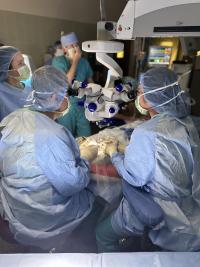
Specialized Eye Surgery Restores Dog’s Vision
Retinal Reattachment Surgery Available for First Time at UC Davis
“Case of the Month” – January 2025

When their dog Tashi started looking around aimlessly recently, owners Jerry and Arlet Nordeen thought something might be wrong with their beloved 7-year-old Shih-Tzu. When this progressed into bumping into furniture and being hesitant to jump, they took her to see a veterinary ophthalmologist who diagnosed her with detached retinas in both eyes which was taking her vision.
The Nordeens were referred to a specialist in Southern California, previously the only ophthalmologist in California who performed retinal reattachment surgery. Thinking there might be an option closer to home, Arlet’s sister, Sonia Hallera, suggested they check with UC Davis.
“When my son Jaime’s dogs Keira and Riley were sick, UC Davis was there for us,” said Hallera. “Even though we lost Keira to cancer, the attention and care she received at UC Davis was outstanding. I hoped Jerry and Arlet could find the same for Tashi.”
After calling UC Davis, the Nordeens discovered the veterinary school recently purchased a new microscope which allows them to perform the surgery as well, becoming only the second veterinary facility in the state with such capabilities.
“We were pleased to hear UC Davis can now do the surgery,” Jerry said. “That saved us a six-hour drive to Los Angeles.”

In 2024, the UC Davis veterinary hospital’s Ophthalmology Service acquired an upgraded surgical microscope with technology that is not available in many veterinary ophthalmology practices. The microscope is equipped with a back-of-the-eye viewing system that offers surgeons a clear and uncompromised view of the retina and other anatomical areas of the rear of the eye. This makes retinal reattachment surgery available now for the first time at UC Davis.
“To our knowledge, we are the first veterinary school in the U.S. to perform retinal reattachment surgery in its teaching hospital,” said Dr. Soohyun Kim, assistant professor of clinical ophthalmology. “Most likely, there are less than 10 private practice ophthalmologists nationwide performing the surgery. It’s extremely specialized care in veterinary medicine.”
Tashi’s condition is most likely congenital. Certain breeds, such as the Shih Tzus, Bichon Frises, and Border Collies, are more susceptible to retinal detachment.
“We found out later that Tashi’s mother and father were siblings,” said Jerry. “So, that most likely compounded any genetic issues her breed already has.”
Based on Tashi’s pre-surgery examinations, she was deemed a good candidate for retinal reattachment surgery. Dr. Kim discussed the procedure and potential surgical complications with the Nordeens. All agreed that surgery was best for Tashi.
Retinal reattachment surgery, called retinopexy, is the only way to repair a retinal tear and restore vision. The procedure aims to repair the detached retina and secure it back to its proper position. Dr. Kim identified Tashi’s retinal tears and repositioned the retina by removing a natural gel that fills the space between the lens and the retina and replacing it with silicone oil. Once Tashi’s retina was in place, she used a laser treatment to create scar tissue around the retinal breaks, effectively sealing them.

“The success rate of restoring the retina’s position is more than 90–95%,” said Dr. Kim. “Our new retinal surgery system, comparable to those used in human hospitals, contributes to this high success rate.”
Prompt retinal reattachment halts the progression of partial detachment and prevents further retinal damage. But, that doesn’t complete the vision restoration process. For the light-sensitive cells to regain function, they need to reconnect, which can take a few weeks to a few months. The duration of the detachment is critical for functional sight recovery. In general, the overall success rate for regaining vision after retinal reattachment surgery is between 50-80%, depending on the patient.
Tashi—Tibetan for “good fortune”—recovered ideally from anesthesia and surgery. She was hospitalized for one night and then discharged home.
She has had several follow-up appointments over the past two months since surgery. For the first month, both of Tashi’s eyes were open and comfortable, with normal intraocular pressures. Jerry even noticed she was tracking squirrels from 15 feet away.
However, Tashi did develop some complications with her right eye after about five weeks, which the Nordeens continue to work with Dr. Kim to resolve. Even though Tashi is still being treated for issues in her right eye, her owners are pleased they went through with the surgery, which successfully restored vision to her left eye.
“She’s only 7 years old,” Jerry said. “She still has a lot of good years ahead. We just couldn’t let her go blind.”
# # #
